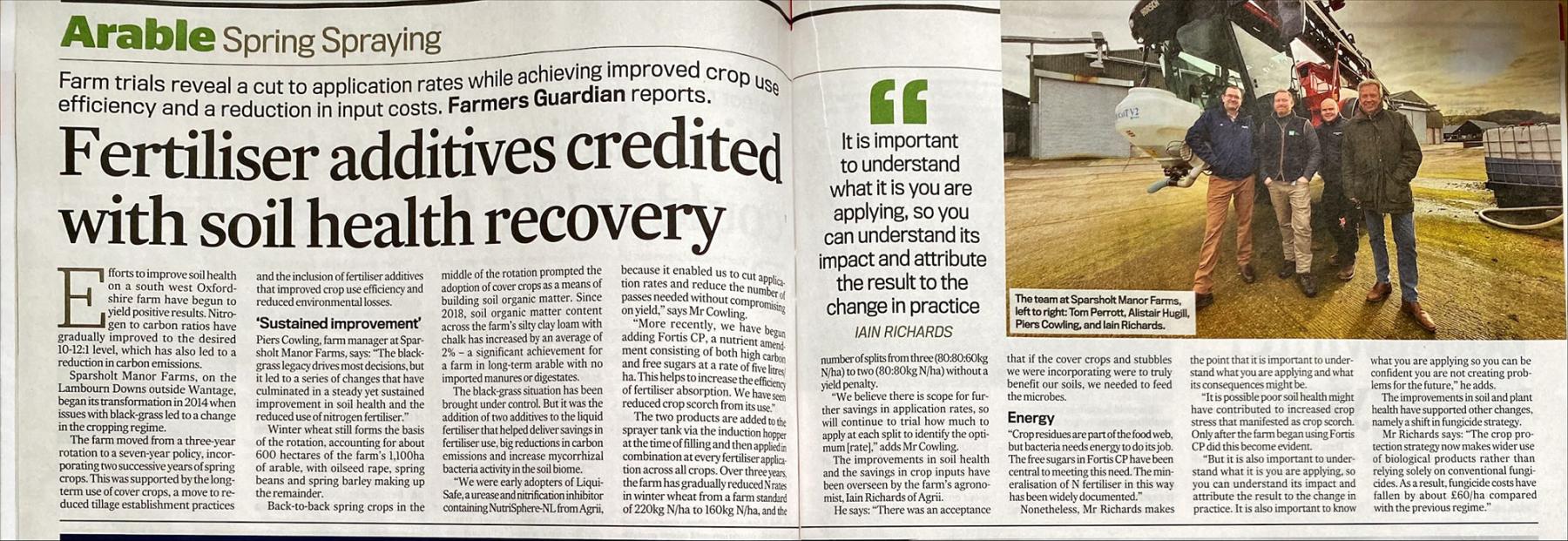ED&F Man Agronomy Farmers Guardian February 2025
Efforts to improve soil health on a south west Oxfordshire farm have begun to yield positive results. Nitrogen to carbon ratios have gradually improved to the desired 10-12:1 level, which has also led to a reduction in carbon emissions.
Sparsholt Manor Farms, on the Lamboum Downs outside Wantage, began its transformation in 2014 when issues with black-grass led to a change in the cropping regime.
The farm moved from a three-year rotation to a seven-year policy, incorporating two successive years of spring crops. This was supported by the longterm use of cover crops, a move to reduced tillage establishment practices and the inclusion of fertiliser additives that improved crop use efficiency and reduced environmental losses.
Sustained improvement
Piers Cowling, farm manager at Sparsholt Manor Farms, says: “The blackgrass legacy drives most decisions, but it led to a series of changes that have culminated in a steady yet sustained improvement in soil health and the reduced use of nitrogen fertiliser.”
Winter wheat still forms the basis of the rotation, accounting for about 600 hectares of the farm’s l,100ha of arable, with oilseed rape, spring beans and spring barley making up the remainder.
Back-to-back spring crops in the middle of the rotation prompted the adoption of cover crops as a means of building soil organic matter. Since 2018, soil organic matter content across the farm’s silty clay loam with chalk has increased by an average of 2% – a significant achievement for a farm in long-term arable with no imported manures or digestates.
The black-grass situation has been brought under control. But it was the addition of two additives to the liquid fertiliser that helped deliver savings in fertiliser use, big reductions in carbon emissions and increase mycorrhizal bacteria activity in the soil biome.
“We were early adopters of Liqui-Safe, a urease and nitrification inhibitor containing NutriSphere-NL from Agrii, because it enabled us to cut application rates and reduce the number of passes needed without compromit on yield,” says Mr Cowling.
“More recently, we have begun adding Fortis CP, a nutrient amendment consisting of both high carbon and free sugars at a rate of five litres ha. This helps to increase the efficiency of fertiliser absorption. We have seen reduced crop scorch from its use.”
The two products are added to the sprayer tank via the induction hopper at the time of filling and then applied in combination at every fertiliser application across all crops. Over three years, the farm has gradually reduced N rates in winter wheat from a farm standard of 220kg N/ha to 160kg N/ha, and the number of splits from three (80:80:60kg N/ha) to two (80:80kg N/ha) without a yield penalty.
“We believe there is scope for further savings in application rates, so will continue to trial how much to apply at each split to identify the optimum [rate],” adds Mr Cowling.
The improvements in soil health and the savings in crop inputs have been overseen by the farm’s agronomist, Iain Richards of Agrii.
He says: “There was an acceptance that if the cover crops and stubbles we were incorporating were to truly benefit our soils, we needed to feed the microbes.
Energy
“Crop residues are part of the food web. but bacteria needs energy to do its job. The free sugars in Fortis CP have been central to meeting this need. The mineralisation of N fertiliser in this way has been widely documented.”
Nonetheless, Mr Richards makes the point that it is important to understand what you are applying and what its consequences might be.
“It is possible poor soil health might have contributed to increased crop stress that manifested as crop scorch. Only after the farm began using Fortis CP did this become evident
“But it is also important to understand what it is you are applying, so you can understand its impact and attribute the result to the change in practice. It is also important to know what you are applying so you can be confident you are not creating problems for the future,” he adds.
The improvements in soil and plant health have supported other changes, namely a shift in fungicide strategy.
Mr Richards says: “The crop protection strategy now makes wider use of biological products rather than relying solely on conventional fungicides. As a result, fungicide costs have fallen by about £60/ha compared with the previous regime.”


